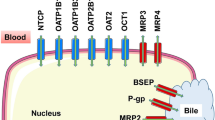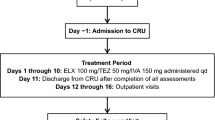Abstract
Background and Objective
Human in vitro and dog in vitro/in vivo researches indicate that the drug–drug interaction (DDI) of decreased plasma valproic acid (VPA) concentration by co-administration of carbapenem antibiotics is caused by inhibition of acylpeptide hydrolase (APEH)-mediated VPA acylglucuronide (VPA-G) hydrolysis by carbapenems. In this study, we investigated VPA disposition and APEH activities in TK-NOG chimeric mice, whose livers were highly replaced with human hepatocytes, to evaluate the utility of this animal model and the clinical relevance of the DDI mechanism.
Methods
VPA and VPA-G concentrations in plasma, urinary excretion of VPA-G and APEH activity in humanized livers were measured after co-administration of VPA with meropenem (MEPM) to chimeric mice.
Results
After co-administration with MEPM to the chimeric mice, plasma VPA concentration more rapidly decreased than without the co-administration. An increase in plasma AUC and urinary excretion of VPA-G was also observed. APEH activity in humanized livers was strongly inhibited even at 24 h after co-administration of MEPM to the chimeric mice.
Conclusion
The DDI of VPA with carbapenems was successfully observed in chimeric mice with humanized livers. The DDI was caused by long-lasting inhibition of hepatic APEH-mediated VPA-G hydrolysis by carbapenems, which strongly supports the APEH-mediated mechanism of the clinical DDI. This is the first example showing the usefulness of chimeric mice with humanized livers for evaluation of a DDI via non-cytochrome P450 enzyme.


Similar content being viewed by others
References
Jaiswal S, Sharma A, Shukla M, Vaghasiya K, Rangaraj N, Lal J. Novel pre-clinical methodologies for pharmacokinetic drug-drug interaction studies: spotlight on “humanized” animal models. Drug Metab Rev. 2014;46:475–93.
Hasegawa M, Kawai K, Mitsui T, Taniguchi K, Monnai M, Wakui M, Ito M, Suematsu M, Peltz G, Nakamura M, Suemizu H. The reconstituted ‘humanized liver’ in TK-NOG mice is mature and functional. Biochem Biophys Res Commun. 2011;405:405–10.
Yoshizato K, Tateno C. In vivo modeling of human liver for pharmacological study using humanized mouse. Expert Opin Drug Metab Toxicol. 2009;5:1435–46.
De Jong YP, Rice CM, Ploss A. New horizons for studying human hepatotropic infections. J Clin Invest. 2010;120:650–3.
Kamimura H, Ito S. Assessment of chimeric mice with humanized livers in new drug development: generation of pharmacokinetics, metabolism and toxicity data for selecting the final candidate compound. Xenobiotica. 2016;46:557–69.
Scheer N, Wilson ID. A comparison between genetically humanized and chimeric liver humanized mouse models for studies in drug metabolism and toxicity. Drug Discov Today. 2016;21:250–63.
Nishimura T, Hu Y, Wu M, Pham E, Suemizu H, Elazar M, Liu M, Idilman R, Yurdaydin C, Angus P, Stedman C, Murphy B, Glenn J, Nakamura M, Nomura T, Chen Y, Zheng M, Fitch WL, Peltz G. Using chimeric mice with humanized livers to predict human drug metabolism and a drug–drug interaction. J Pharmacol Exp Ther. 2013;344:388–96.
Yamazaki H, Suemizu H, Murayama N, Utoh M, Shibata N, Nakamura M, Guengerich FP. In vivo drug interactions of the teratogen thalidomide with midazolam: heterotropic cooperativity of human cytochrome P450 in humanized TK-NOG mice. Chem Res Toxicol. 2013;26:486–9.
Nagai K, Shimizu T, Togo A, Takeya M, Yokomizo Y, Sakata Y, Matsuishi T, Kato H. Decrease in serum levels of valproic acid during treatment with a new carbapenem, panipenem/betamipron. J Antimicrob Chemother. 1997;39:295–6.
De Turck BJ, Diltoer MW, Cornelis PJ, Maes V, Spapen HD, Camu F, Huyghens LP. Lowering of plasma valproic acid concentrations during concomitant therapy with meropenem and amikacin. J Antimicrob Chemother. 1998;42:563–4.
Yokogawa K, Iwashita S, Kubota A, Sasaki Y, Ishizaki J, Kawahara M, Matsushita R, Kimura K, Ichimura F, Miyamoto K. Effect of meropenem on disposition kinetics of valproate and its metabolites in rabbits. Pharm Res. 2001;18:1320–6.
Nakajima Y, Mizobuchi M, Nakamura M, Takagi H, Inagaki H, Kominami G, Koike M, Yamaguchi T. Mechanism of the drug interaction between valproic acid and carbapenem antibiotics in monkeys and rats. Drug Metab Dispos. 2004;32:1383–91.
Suzuki E, Yamamura N, Ogura Y, Nakai D, Kubota K, Kobayashi N, Miura S, Okazaki O. Identification of valproic acid glucuronide hydrolase as a key enzyme for the interaction of valproic acid with carbapenem antibiotics. Drug Metab Dispos. 2010;38:1538–44.
Perrier J, Durand A, Giardina T, Puigserver A. Catabolism of intracellular N-terminal acetylated proteins: involvement of acylpeptide hydrolase and acylase. Biochimie. 2005;87:673–85.
Scaloni A, Barra D, Jones WM, Manning JM. Human acylpeptide hydrolase. Studies on its thiol groups and mechanism of action. J Biol Chem. 1994;269:15076–84.
Suzuki E, Nakai D, Yamamura N, Kobayashi N, Okazaki O, Izumi T. Inhibition mechanism of carbapenem antibiotics on acylpeptide hydrolase, a key enzyme in the interaction with valproic acid. Xenobiotica. 2011;41:958–63.
Suzuki E, Nakai D, Ikenaga H, Fusegawa K, Goda R, Kobayashi N, Kuga H, Izumi T. In vivo inhibition of acylpeptide hydrolase by carbapenem antibiotics causes the decrease of plasma concentration of valproic acid in dogs. Xenobiotica. 2016;46(2):126–31.
Gugler R, Von Unruh GE. Clinical pharmacokinetics of valproic acid. Clin Pharmacokinet. 1980;5:67–83.
Kamimura H, Ito S, Nozawa K, Nakamura S, Chijiwa H, Nagatsuka S, Kuronuma M, Ohnishi Y, Suemizu H, Ninomiya S. Formation of the accumulative human metabolite and human-specific glutathione conjugate of diclofenac in TK-NOG chimeric mice with humanized livers. Drug Metab Dispos. 2015;43:309–16.
Miyaguchi T, Suemizu H, Shimizu M, Shida S, Nishiyama S, Takano R, Murayama N, Yamazaki H. Human urine and plasma concentrations of bisphenol A extrapolated from pharmacokinetics established in in vivo experiments with chimeric mice with humanized liver and semi-physiological pharmacokinetic modeling. Regul Toxicol Pharmacol. 2015;72:71–6.
Yamamura N, Imura K, Naganuma H, Nishimura K. Panipenem, a carbapenem antibiotic, enhances the glucuronidation of intravenously administered valproic acid in rats. Drug Metab Dispos. 1999;27:724–30.
Abbott. Depakene (valproic acid) Prescribing information. https://www.accessdata.fda.gov/drugsatfda_docs/label/2011/018081s046_18082s031lbl.pdf. Accessed 13 Apr 2017.
Yamamura N, Imura-Miyoshi K, Naganuma H. Panipenum, a carbapenem antibiotic, increases the level of hepatic UDP-glucuronic acid in rats. Drug Metab Dispos. 2000;28:1484–6.
Soars MG, Riley RJ, Findlay KA, Coffey MJ, Burchell B. Evidence for significant differences in microsomal drug glucuronidation by canine and human liver and kidney. Drug Metab Dispos. 2001;29:121–6.
Sumita Y, Nouda H, Tada E, Kohzuki T, Kato M, Okuda T, Fukasawa M. Pharmacokinetics of meropenem, a new carbapenem antibiotic, parenterally administrated to laboratory animals. Jpn J Chemother. 1992;40(Suppl 1):123–31.
Mitta M, Ohnogi H, Mizutani S, Sakiyama F, Kato I, Tsunasawa S. The nucleotide sequence of human acylamino acid-releasing enzyme. DNA Res. 1996;3:31–5.
Lunde JL, Nelson RE, Storandt HF. Acute seizures in a patient receiving divalproex sodium after starting ertapenem therapy. Pharmacotherapy. 2007;27:1202–5.
Haroutiunian S, Ratz Y, Rabinovich B, Adam M, Hoffman A. Valproic acid plasma concentration decreases in a dose-independent manner following administration of meropenem: a retrospective study. J Clin Pharmacol. 2009;49:1363–9.
Taha FA, Hammond DN, Sheth RD. Seizures from valproate–carbapenem interaction. Pediatr Neurol. 2013;49:279–81.
Acknowledgements
We gratefully acknowledge Toshihiko Namba for the expert help with the animal experimental environment.
Author information
Authors and Affiliations
Corresponding author
Ethics declarations
Conflict of interest
The authors report no conflicts of interest. The authors alone are responsible for the content and writing of the paper.
Ethical approval
All procedures performed in studies involving animals were in accordance with the ethical standards of practices of the institutions at which the studies were conducted.
Rights and permissions
About this article
Cite this article
Suzuki, E., Koyama, K., Nakai, D. et al. Observation of Clinically Relevant Drug Interaction in Chimeric Mice with Humanized Livers: The Case of Valproic Acid and Carbapenem Antibiotics. Eur J Drug Metab Pharmacokinet 42, 965–972 (2017). https://doi.org/10.1007/s13318-017-0413-2
Published:
Issue Date:
DOI: https://doi.org/10.1007/s13318-017-0413-2




